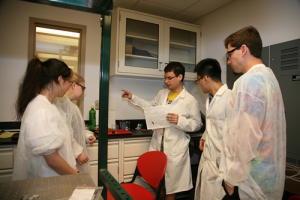The summer semester offers a perfect opportunity for undergraduates to conduct engineering research under the mentorship of a faculty member. Cullen College of Engineering undergraduates selected for the Summer Undergraduate Research Fellowship (SURF) gained practical experience in research methods and a newfound interest in the science of innovation.
David Pineda, a mechanical engineering junior, has been working in assistant professor Yan Yao’s newly-created Laboratory of Energy Materials and Devices. His project is the construction of a vanadium redox flow battery system.
Similar to a fuel cell, the vanadium redox (reduction-oxidation) battery comprises a power cell in which electrolytes flow from external tanks into the central stack where reactions take place and electrons are created. The focus of Pineda’s project is to create a platform, or small scale vanadium redox battery for the development of inexpensive, novel materials used to replace electrolyte solutions and membrane.
While vanadium redox battery systems are rare or not widely used, they hold potential for large-scale applications, including emergency power backup.
“One of the problems with the current energy grid is that it isn’t able to adjust to fluctuations between main supply and consumer demand in the main supply,” Pineda said. “During the day, when we need a lot of electricity the power plant can only supply a constant maximum amount - it cannot downgrade or upgrade very efficiently. So at night, when less electricity is used, the day’s collection of electricity is wasted. Energy storage is needed to bridge this gap, such that nighttime excess electricity can be used during the day when demand is at its highest.”
The vanadium redox flow battery hasn’t been widely applied due to its expense. The cost of the active material, vanadium, rises with high demand in the steel industry. Additionally, the cost of the proton exchange membrane (the component inside the central stack where positive ions flow to the negative side, creating a complete circuit) accounts for about 40 percent of the overall cost. The goal is to produce cost-effective materials that allow more efficient permeation of ions.
Pineda’s research is self-managed – he scouts new materials and creates the best ways of putting them together. The ability to direct the research is something that motivates Pineda.
“The main reason I decided to come into the SURF program was to find out what research is all about,” Pineda said, who feels confident in his choice to pursue graduate studies and after that, research and analysis in industry.
Pineda emphasizes that research is a very open, non-linear, improvisational process. “A lot of the things you do in research haven’t been done before,” he said. For engineering students wishing to explore research areas, the most important characteristics to have are curiosity and ambition. “You’re on your own; you can’t go to a textbook and find a solution. It’s not easy but it’s rewarding if you put in the time and effort. Get a clear picture of how your field applies to real life. Start reading about research that’s going on here, and other places. Be knowledge-hungry. The best way to learn is by experience itself.”
The Summer Undergraduate Research Fellowship program at the University of Houston seeks to provide funding for rising UH sophomores, juniors, and seniors to participate in a focused, full-time, 10-week research experience under the direction of UH faculty. For more information on this and other undergraduate research opportunities, visit the Office of Undergraduate Research.
